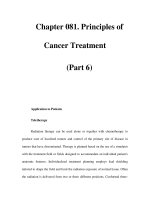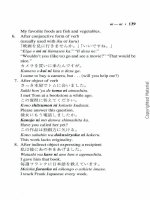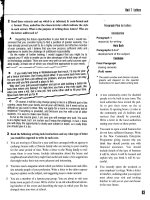learn the Principles of Business Writing PHẦN 6 ppsx
Bạn đang xem bản rút gọn của tài liệu. Xem và tải ngay bản đầy đủ của tài liệu tại đây (154.43 KB, 10 trang )
Substance tends to closely follow or precede meaning, and in fact, substance is some-
times used to create meaning. An example of this could be the following sequence of
sentences:
We are an innovative organisation [statement]. Our customers regularly receive
software updates [substantiation], as a result of which they are able to be more
productive [meaning]. According to the Consumer Protection Society, our cus-
tomers receive more value for money as a result of this [substantiation] and are
eager to recommend our software to colleagues [meaning]. This way, we make
more profit, part of which is earmarked for innovation [meaning].
One word of caution: the principles of focus and substance can pull a text in conflicting
directions. Focus values brevity - this allows the reader to grasp the main issues.
Substantiation requires additional information that adds context and detail. While you
should not choose one principle at the expense of the other, you need to balance the
two.
For the sake of efficiency and control, it’s probably best to use focus as the lead prin-
ciple. Focus guides you when building a text from the ground up, particularly when the
process is guided by a brief and an outline. Once the main structure of the text has
been prepared, and the text meets the goals and needs of the project, you are free to
add details.
c a p t u r e . d e l i v e r . e x ce l . su b s ta n c e 51
52 w w w . c a p t u r e d e l i v e r e x c e l . c o m
Structure
Structure helps readers to relate to the purpose and meaning of a text, even when
the subject matter is highly complex. A good structure leads the reader through your
text by using techniques like sequence, consistency, guidance and balance.
As we discussed in the chapter on focus, most business subjects are so complex you
need to limit what and how you write. By choosing the right scope and scale of your
text, you can make the writing manageable for yourself and pleasing to readers. Now,
if focus allows you to develop a writing strategy, then structure is your way to exe-
cute it. This chapter suggest ways to improve the structure of a text, specifically by
using techniques called sequence, consistency, guidance and balance.
Sequence
Sequence is the order in which your story unfolds. A good sequence creates flow, or
an order of events that is so natural that the reader can follow the text without any
difficulty. A good sequence has a logical transition from sentence to sentence and pa-
ragraph to paragraph. Ideally, each paragraph is a stepping stone to the next, preparing
the reader to understand more. A simple question to ask while writing is: does this
paragraph or sentence help the reader to understand the next one?
A sequence of paragraphs dealing with a new product X could be:
- Description of how people solve a particular problem in their life
- Limitations of available products
- Consequences of these limitations
- Product X features, compared to existing products
- Product X benefits, compared to existing products
- What Product X could mean to people’s lives
the fifth principle
c a p t u r e . d e l i v e r . e x ce l . stru c t u r e 53
54 w w w . c a p t u r e d e l i v e r e x c e l . c o m
A sequence of paragraphs for a presentation of a team’s plan for next year could be as
follows:
- Last year’s business environment
- Last year’s goals and outcomes
- Changes in the business environment
- Challenges and opportunities
- Next year’s goals
- Action required to achieve these goals
- People, processes and budget needed to accomplish these goals
Consistency
Consistency is an important tool for guiding the reader through a story. Using the
same style, point of view, and the same words when referring to the same object
prevents misunderstandings. Specifically:
- Be careful when a text is the result of team work, particularly when several
people have commented on draft versions of the text. This usually results in
a patchwork of styles, making it hard for the reader to focus. The chapter on
the writing process shares some tips on dealing with this.
- Refer to people, places and things in the same way. If you are talking about
a new digital camera, use either ‘the camera’ or the product name ‘Image-
View 1300-Z’. If you are writing about Joe Smith, refer to him as ‘Mr Smith’,
‘Smith’ or ‘Joe’, but don’t mix all three in the same text.
- Use the same point of view. Do you use the first person plural ‘we’ or third
person singular ‘the organisation’? The first option is more subjective, perso-
nal and is well suited for internal communication purposes. The second option
is more suited to objective analysis used in external publications. Whatever
perspective you use, don’t mix the two styles.
c a p t u r e . d e l i v e r . e x ce l . stru c t u r e 55
56 w w w . c a p t u r e d e l i v e r e x c e l . c o m
Guidance
Sequence and consistency help you to structure the story in the best possible way
on a macro level. On a micro level, when dealing with individual sentences and words,
you can help the reader navigate the text using cue words. These guide the reader in
connecting different parts of the story, pay particular attention to what is about to be
discussed and see relevant relations or discrepancies. The following are examples of
such techniques:
Priming
Priming is a technique used to focus readers’ attention on a specific part of the text.
Priming is used to indicate the transition into a new segment, a relationship between
two parts of a text or something that is yet to be discussed. Examples are:
- ‘Once that part of the process was finalised, we’
- ‘As the next slide will show’
- ‘but this will be dealt with more extensively when’
- ‘This will be discussed in chapter six’
- ‘This means that’
- ‘As result of that’
- ‘Due to this’
- ‘As a consequence’
Juxtapositions
Showing relevant differences between aspects of an issue can lead to valuable in-
sights. It can show alternative perspectives or pinpoint dilemmas. These cue words
are best used at the beginning of sentences or paragraphs, where they are easy to
spot. This also allows readers to scan the text quickly for the relevant parts. Examples
include:
- However: ‘Last year, we said we would cut costs. However, we didn’t
achieve this goal.’
- Nevertheless: ‘We focused our resources on developing product X. Never-
c a p t u r e . d e l i v e r . e x ce l . stru c t u r e 57
58 w w w . c a p t u r e d e l i v e r e x c e l . c o m
theless, we allowed a small team to use their spare time to
develop product Y.’
At the same time: ‘We have reduced the number of staff to 1,500, but at the
same time we hired more staff in the other business unit.’
Irrespective: ‘Irrespective of the team’s performance this quarter, we will
get a bonus this year.’
In spite of: ‘In spite of the performance of the Widgets Division, the CEO
will not step down.’
Commonalities
By emphasising what is common across two or more issues, you can build rapport
with the reader, particularly when the shared qualities are closely linked to the reader’s
values and beliefs. To emphasise commonalities, use words like:
Similar to: ‘This part of the process is similar to the one we tackled last
year, in that it is ’
Share: ‘Even though our departments appear to have different
views, we share many of the values and interests that make
us who we are.’
Together: ‘Together, we can make sure this company becomes even
stronger that it already is.’
Repetition
A good structure uses repetition to reinforce meaning or help readers understand a
sequence of arguments. It can also be used as a stepping stone from one part of the
text to another one. The following could have been taken from a speech in which a
CEO announced a change programme:
‘As I said earlier, we are facing two challenges. I have discussed the first one,
more stringent legislation, and would like to move to the second challenge, a new
competitor.’
Summarising
You may find it useful to end a segment in your story with a recap of the main points.
Summaries within a text offer a natural point for reflection and indicate that a new
part of the story is about to start. If, for example, a business case has so far discussed
market developments in, say, MP3 players and then discussed the company’s pipeline,
then a way to start the next segment on innovation could be something like this:
c a p t u r e . d e l i v e r . e x ce l . stru c t u r e 59
60 w w w . c a p t u r e d e l i v e r e x c e l . c o m









